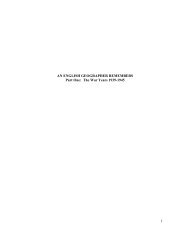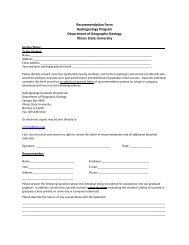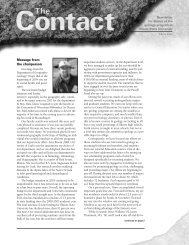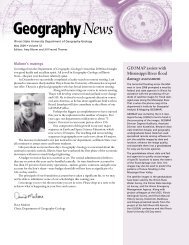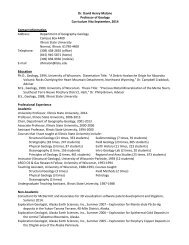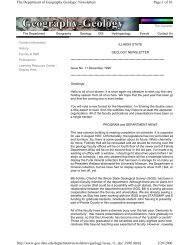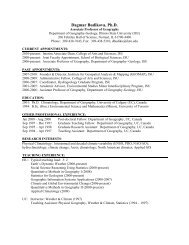Glacial Deposits.indd - Department of Geography - Geology - Illinois ...
Glacial Deposits.indd - Department of Geography - Geology - Illinois ...
Glacial Deposits.indd - Department of Geography - Geology - Illinois ...
You also want an ePaper? Increase the reach of your titles
YUMPU automatically turns print PDFs into web optimized ePapers that Google loves.
The prairie plot, itself, is inside the bounds <strong>of</strong> the larger property, separated from the<br />
surrounding acreage by windbreaks, a pond, and roads. Morgan calls this acreage his “gift to<br />
Earth.” It seems, though, that he is receiving the greater gift, as various creatures stop in to visit<br />
on their migrations north and south, or build a nest to claim this land as home. Part <strong>of</strong> his intent<br />
was to create wildlife habitat; he does not have to wait years to see this dream come to fruition,<br />
as it is already acting as a refuge in a seasonal sea <strong>of</strong> corn and soybeans. Part <strong>of</strong> his intent in<br />
planting this plot was to honor Earth in conjunction with the rules <strong>of</strong> the federal Conservation<br />
Reserve Program; his part in planting native grasses and forbs trumps merely leaving the<br />
ground untilled. Mostly, though, he wanted to see what would happen; he is already seeing the<br />
results, as grasses take hold and shoot their seeds two feet high toward the light and wind the<br />
very first summer, an unexpected marvel and testament to the strength <strong>of</strong> the soil and wisdom<br />
<strong>of</strong> using local genotypes.<br />
Already, he has seen quail and pheasant, bees, and meadowlarks. With the pond nearby, the<br />
property gets a wealth <strong>of</strong> migratory species, including water birds such as gadwalls; northern<br />
shovelers; and even a bittern, a rarity among these parts. The riparian zones favor muskrat,<br />
beaver, and deer; and the pond is stocked with several different species <strong>of</strong> fish. He installed a<br />
purple martin house, which hosted nearly 50 martins in 2009. He also installed a bluebird house<br />
a young friend built, which has yet to attract residents; but they have high hopes for the next<br />
nesting season. As the prairie grows stronger through the years, it will host an even wider<br />
variety <strong>of</strong> wildlife, which is part <strong>of</strong> Morgan’s hopes for the property.<br />
“To mow or not to mow” was the first year’s most pressing question. On the one hand, mowing<br />
would keep the weeds at bay, giving the tender new shoots a chance to establish themselves<br />
more quickly. On the other hand, the prairie grasses and forbs are strong, resilient plants,<br />
capable <strong>of</strong> making it on their own. He decided to exercise patience, letting the prairie develop in<br />
its own time, without the aid <strong>of</strong> mowers. This means that his work for year one was completed<br />
with the act <strong>of</strong> seeding. Now the prairie is on its own, and he has the confidence that letting it<br />
develop in its own way is the best course <strong>of</strong> action.<br />
Morgan’s background is not ecology, or biology, or agriculture. He is a retired <strong>Illinois</strong> State<br />
English pr<strong>of</strong>essor, with a deep love <strong>of</strong> the land. He derives great enjoyment from connecting<br />
with the land, as a fisherman, a bird watcher, or a philosopher, and now as the steward <strong>of</strong> his<br />
own little prairie. His control <strong>of</strong> the property is not really control at all; once the seeds were<br />
properly planted, the prairie assumed control, and he is content to surrender to the wisdom <strong>of</strong><br />
native plants.<br />
Maintenance <strong>of</strong> the surrounding land helps the prairie by shielding harsh winds, providing cover<br />
for the wildlife that will fertilize and pollinate it, and controlling water to prevent the still-delicate<br />
soil from washing away. On the surrounding property he has planted a three-tiered windbreak <strong>of</strong><br />
deciduous trees, conifers, and shrubs, and maintained the grass waterways. All <strong>of</strong> this helps to<br />
protect and nurture the prairie growing within its midst.<br />
So what is next For Morgan, it is the peace <strong>of</strong> knowing that he has given something back to the<br />
land; the contentment <strong>of</strong> leaving something <strong>of</strong> value to his heirs; and the enjoyment <strong>of</strong> watching<br />
the seasons nurture, stress, and strengthen the prairie. It is a labor <strong>of</strong> love. It is a tangible prayer<br />
for the future. It is an island <strong>of</strong> tranquility for his feathered and furred neighbors. It is the comfort<br />
<strong>of</strong> doing the right thing. Whether it lasts five years or 50, it is the right thing now and for the<br />
foreseeable future.<br />
11



